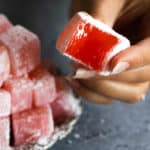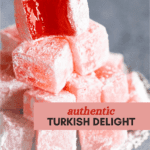Description
With the help of food science, this authentic Turkish delight recipe from Narnia is as close to foolproof as a confectionery recipe can get. Perfectly chewy and sweet, "lokum" is traditionally vegan & gluten-free. Read on to find out its fascinating history, as well as all the key tips and troubleshooting suggestions for Turkish delight.
Ingredients
For Lokum:
- 350 g (scant 2 cups) white sugar (See Note 1)
- 175 ml (3/4 cup) water (for syrup)
- 1.8 g (1/4 teaspoon) citric acid (See Note 2)
- 70 g (1/2 cup + 1 tablespoon) cornstarch
- 500 ml (2 cups + 5 teaspoons) water (for cornstarch)
- 1 1/2 teaspoons rosewater (See Note 3)
- 10 drops of red food color (See Note 4)
For Cutting:
- 30 g (1/4 cup) cornstarch
For Dredging:
- 80 g (2/3 cup) cornstarch
- 45 g (1/3 cup) powdered sugar
Notes on the Ingredients:
- Make sure the sugar is the regular white variety as the less processed yellow-looking ones will make it difficult to judge the final steps of this recipe where we partially depend on the color.
- You may substitute citric acid with either the same volume of cream of tartar, or x12 the volume of lemon juice. 1 tbsp of lemon juice roughly equals 1/4 tsp of citric acid. However, unlike citric acid or cream of tartar, lemon juice will impart some flavor to your Turkish delight.
- Rose is an acquired taste. Therefore, to some, too much rosewater in the delights may make them taste soapy or perfumy. If you believe you might be in this category, halve the volume of rosewater the recipe calls for and you'll get only the slightest hint. As written, the rose flavor in this recipe is quite muted—but certainly there to compliment the sugar. Feel free to increase the amount if you wish to have a more robust flavor. Not a rosewater fan at all? Try substituting with extracts: orange, mandarin, pomegranate, lemon, and mint are very common flavorings in Turkey. You could also try yuzu, almond, maple, cinnamon, root beer... sky is the limit. Be careful as extracts are often stronger than rosewater in the same amount. At least halving the volume would be a good idea.
- The intensity of food colors varies widely from brand to brand. I used Watkins (liquid), and the initial super bright red color got much paler a few days after lokum set—so you may want to go overboard with how much you add or use another brand in order to have a deep red color.
Instructions
1. Add the sugar, citric acid, and water into a heavy-bottomed pan and mix until the sugar dissolves.
2. Bring the mixture to a boil on high heat, then lower the heat down to a simmer and wait until the syrup reaches 250°F (hard ball stage, See Note 1). Make sure to adjust this temperature for your kitchen's altitude and observe the pan closely—a clipped candy thermometer will give the most reliable results. This should take 15-30 minutes depending on your stove's heat output.
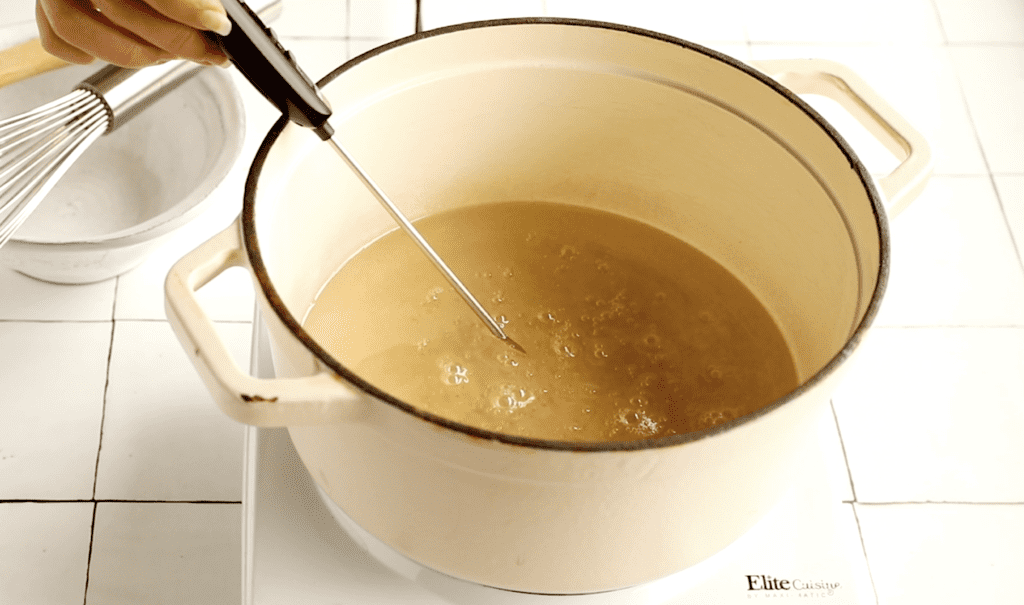
3. Meanwhile, prepare the cornstarch mixture by adding cornstarch and water to a jar. Close the lid and shake vigorously until there are no visible lumps of starch. Alternatively, thoroughly mix in a separate bowl.
4. Once the syrup reaches 250°F, turn off the heat and gradually add the just-shaken cornstarch mix into the pan, whisking continuously.
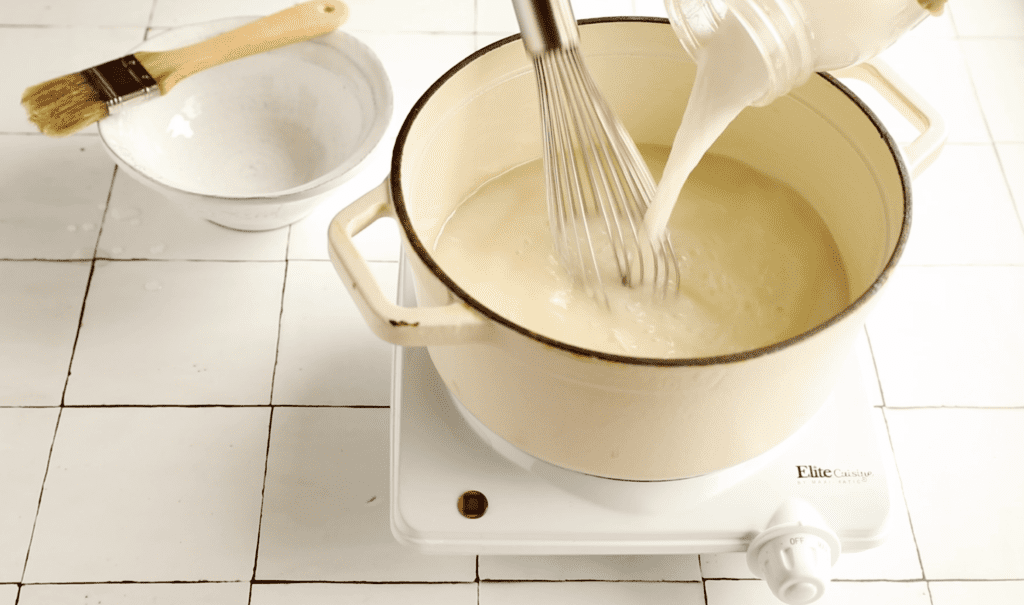
5. When all the cornstarch is incorporated, turn the heat on to medium-low and continue whisking until gelation. It should only take a few minutes for the mixture to thicken.
6. Once it’s thickened, put the heat on low to simmer, and make sure to mix it (See Note 2) about every 6-7 minutes to prevent it from sticking to the bottom. Be careful as the thickened mixture may splatter. Continue this process for 1-2 hours.
7. Prepare a mold by spreading a small amount of neutral oil into a container (See Notes 3 & 4).
8. To judge whether the mixture is done cooking, look for a relatively thick—but not gloopy—texture and a medium-dark shade of amber. Around the 1, 1 1/2-hour mark, the mixture is usually very close to being done. This timeframe will depend on a variety of factors such as pan width & material, changing the ingredient amounts to make more/less lokum, and the burner's heat output. It can go up to 2 hours+, so make sure to judge by texture and color. At this final stage, you may also have to start stirring more frequently, about every 2 minutes.
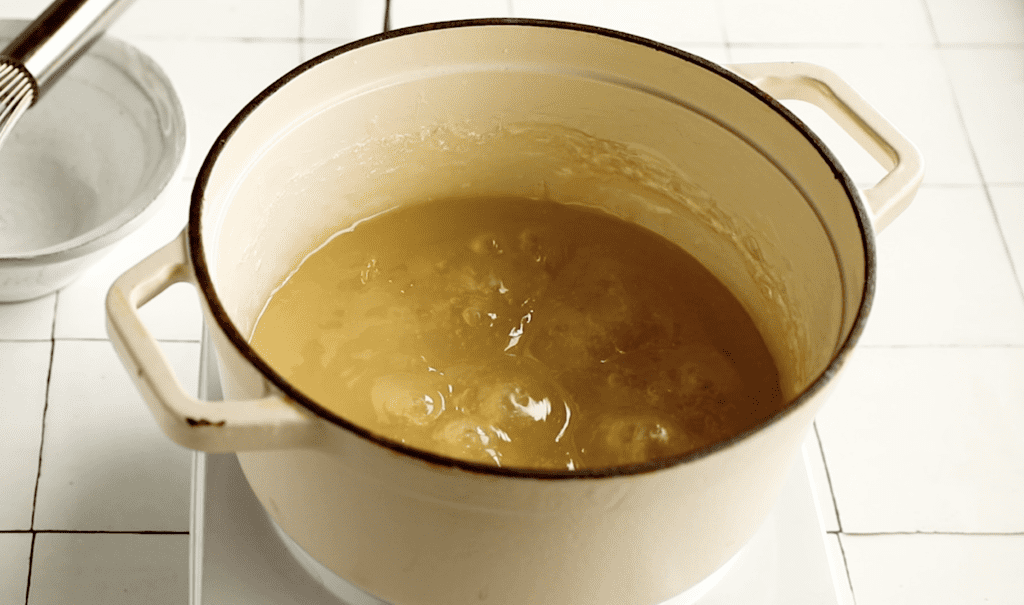
9. When the Turkish delight is done cooking, turn off the heat, and add the rosewater and food coloring. Mix, pour into the container, and set aside at room temperature for at least 5 hours—preferably a full day especially if you’re somewhere hot and humid.
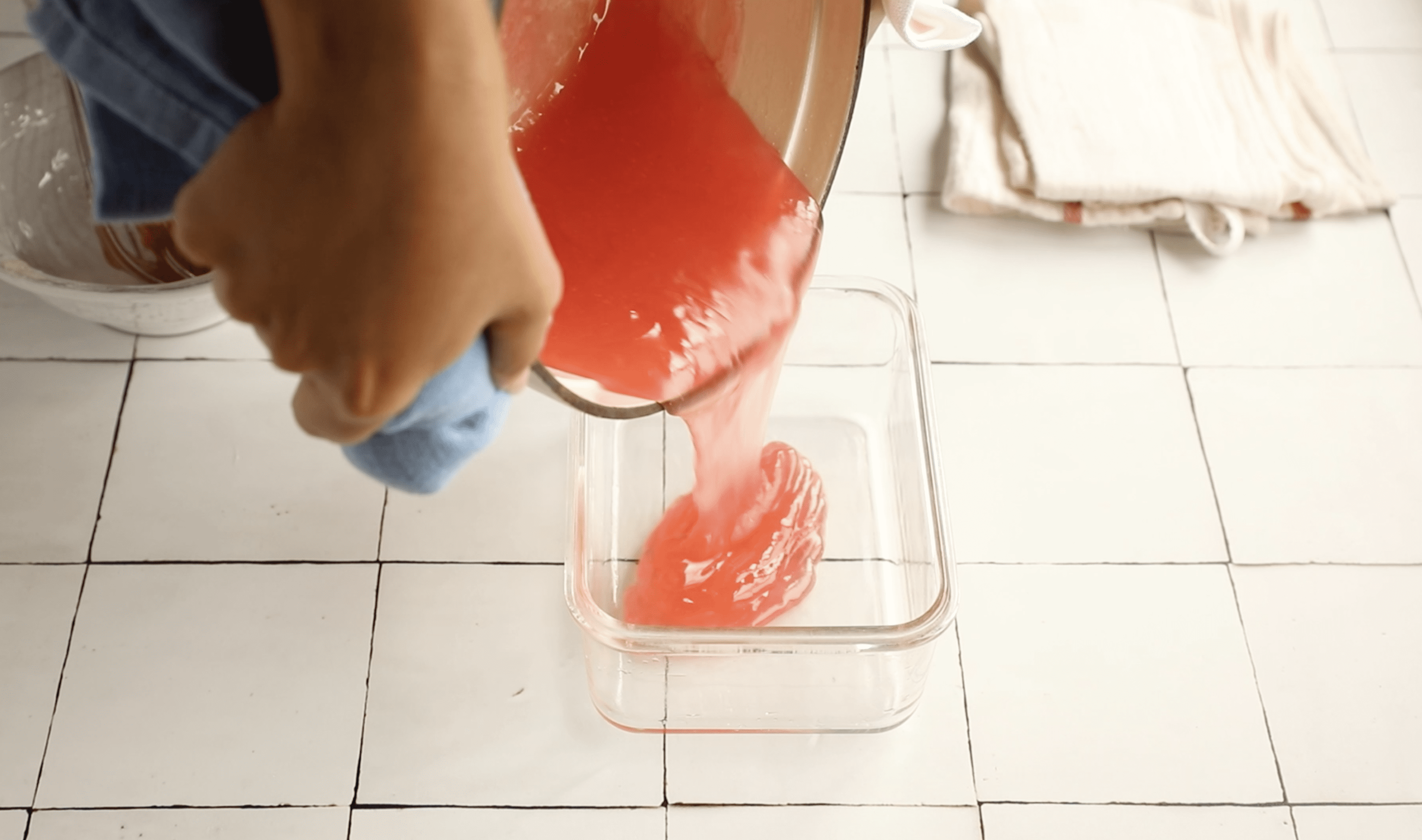
10. The next day, sprinkle cornstarch into the container then cut out a strip from the edge so that you can remove the entire slab. Sprinkle with more cornstarch, then cut into cubes.

11. Once they are cut, dredge the cubes in a mixture of cornstarch and powdered sugar.
12. To maximize the experience, serve with Turkish coffee and water on the side, which is the most common way people consume it in Turkey. Sandwiching the lokum between plain biscuits like Biscoff (or Petibör in Turkey) is really popular as well. These also make a great gift for Christmas. Enjoy!
Notes
1. This is the most crucial part of the recipe. I can't recommend a candy thermometer enough, but in case you're set on making do without, use the cold water test. We’re looking for the hard ball stage: meaning that once you pour a small amount of the simmering syrup into cold water—it should form a hard but malleable ball between your fingers. You need to be very quick in doing this, because the heating rate accelerates very rapidly after about 220°F because of the high sugar concentration in the syrup. Anywhere up to 260°F is okay, but go above this and you will get hard candy without realizing after 2+ hours of cooking.
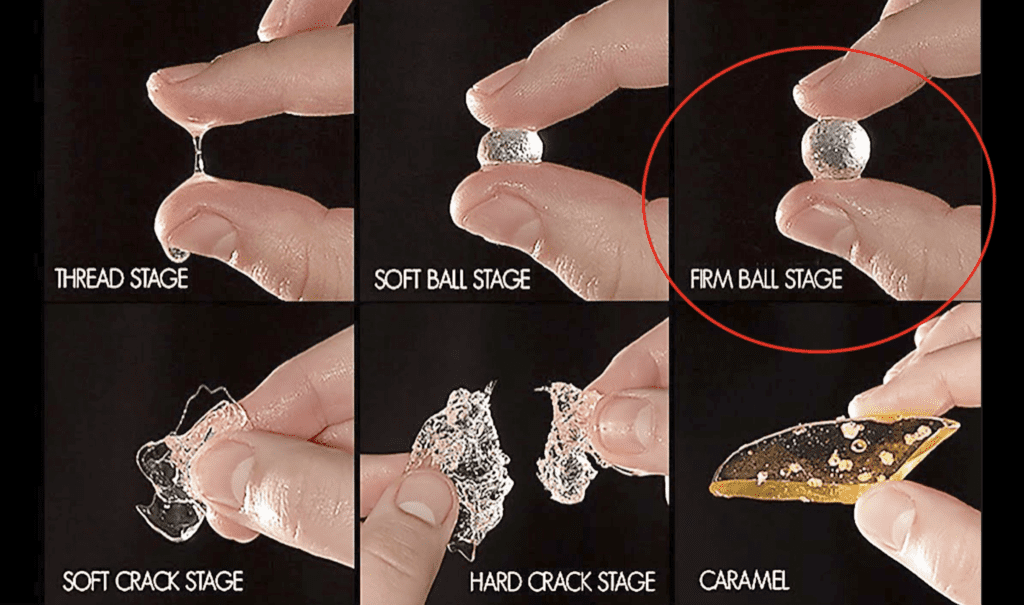
If you are using a candy thermometer, testing it on boiling water to ensure it works correctly is not a bad idea. Additionally, make sure to factor in the altitude of your kitchen. For instance, if you are making this in Denver, CO, you'll be looking for 240°F instead 250°F. Each 500 ft increase in elevation causes water to boil at 1°F lower.
2. Make sure to be gentle while stirring after gelation. Any forceful whisking may cause the starch chains to disintegrate, causing a thinned-out consistency. However, a little thinning after the initial thickening is expected whenever cornstarch gelates.
3. A 5in x 7in glass container used for the original recipe yields 40 ~1-inch cubes of Turkish delight in one layer. However, feel free to use whatever size container is available to you as long as its surface area is smaller than 35 in2. Otherwise, the layer may be too thin.
4. Some prefer to line the container with plastic wrap instead of using oil. While this will help in removing the slab of lokum, it also creates numerous creases on the surface. Therefore I don't prefer it.
5. Store Turkish delights in the refrigerator covered with all the leftover cornstarch & powdered sugar mix from dredging. Prior to serving, make sure to bring Turkish delights back to room temperature. Consume within two weeks for best results.
6. Each 1-inch Turkish delight cube is approximately 45 calories (almost all from carbs). Note that this nutrition information is an estimate provided by Cronometer.
- Prep Time: 10 minutes
- Cook Time: 2 hours 30 minutes
- Category: Dessert
- Method: Cook
- Cuisine: Turkish
Nutrition
- Calories: 45
